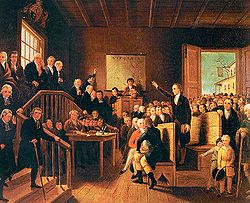
Parson's Cause
Encyclopedia

American Revolution
The American Revolution was the political upheaval during the last half of the 18th century in which thirteen colonies in North America joined together to break free from the British Empire, combining to become the United States of America...
. Colonel John Henry, father of Patrick Henry
Patrick Henry
Patrick Henry was an orator and politician who led the movement for independence in Virginia in the 1770s. A Founding Father, he served as the first and sixth post-colonial Governor of Virginia from 1776 to 1779 and subsequently, from 1784 to 1786...
, was the judge that presided over the court case that decided the issue, and the relatively unknown Patrick Henry advocated in favor of colonial rights in the case.
The case arose with regard to the Two Penny Act
Two Penny Act
The Two Penny Act, enacted in 1758 by the Virginia Assembly, is the act in which the Parson's Cause trial surrounded. The act was issued after three years of drought which produced a low yielding of tobacco crop....
, an act of the Virginia colonial legislature passed in 1758. According to legislation passed in 1748, Virginia's Anglican clergy were to be paid 16,000 pounds of tobacco
Tobacco
Tobacco is an agricultural product processed from the leaves of plants in the genus Nicotiana. It can be consumed, used as a pesticide and, in the form of nicotine tartrate, used in some medicines...
, one of the colony's major crops, per year. Following a poor harvest in 1758, the price of tobacco rose from two to six pennies per pound, effectively inflating clerical salaries. The House of Burgesses responded by passing legislation allowing debts in tobacco to be paid to in currency at a rate of two pennies per pound. King George III of Great Britain veto
Veto
A veto, Latin for "I forbid", is the power of an officer of the state to unilaterally stop an official action, especially enactment of a piece of legislation...
ed the law, causing an uproar. Many Virginia legislators saw the king's veto as a breach of their legislative authority.
The Reverend James Maury
James Maury
The Reverend James Maury was a prominent Virginia educator and minister during the American Colonial period.He was the son of Matthew Maury, a French Huguenot, who was born in Castel Mauron, in Gascony, and his wife, Mary Anne Fontaine, daughter of Rev. James Fontaine and Anne Elizabeth...
, a clergyman, responded to the veto by suing in Hanover County Court (April 1, 1762) for back wages on behalf of all the ministers involved, effectively becoming a representative of the British cause. The court ruled (Nov. 5, 1763) that Maury's claim was valid, but that the amount of damages had to be determined by a jury, which was called for Dec. 1763. Patrick Henry
Patrick Henry
Patrick Henry was an orator and politician who led the movement for independence in Virginia in the 1770s. A Founding Father, he served as the first and sixth post-colonial Governor of Virginia from 1776 to 1779 and subsequently, from 1784 to 1786...
, then relatively unknown, rose to prominence by defending Hanover County
Hanover County, Virginia
As of the census of 2000, there were 86,320 people, 31,121 households, and 24,461 families residing in the county. The population density was 183 people per square mile . There were 32,196 housing units at an average density of 68 per square mile...
against Maury's claims. Henry argued in favor of the Two Penny Act. As reported by the plaintiff Maury in a letter (Dec. 12, 1763) to fellow Anglican minister John Camm
John Camm
Rev. John Camm served as the seventh president of the College of William and Mary. He was a fierce Tory advocate of the prerogative of the Crown and the established Church.-Education:...
shortly after the trial, Henry argued in substance "that a King, by disallowing Acts of this salutary nature, from being the father of his people, degenerated into a Tyrant and forfeits all right to his subjects' obedience." (Ann Maury, "Memoirs of a Huguenot Family," G.P. Putnam & Sons, 1872, letter at pages 418-424, quote at page 421).
The jury awarded Maury only one penny in damages. The award effectively nullified the veto and no other clergy sued.
The Hanover County Courthouse
Hanover County Courthouse
Hanover County Courthouse, built in 1735, is an historic courthouse located in Hanover Court House, Virginia. In 1763, Patrick Henry, who lived and practiced law in Hanover County, argued the case of the Parson's Cause, a case involving King George III's requirement that Virginians pay taxes to...
where Patrick Henry argued the Parson's Cause still remains an active courthouse; located along historic U.S. Route 301
U.S. Route 301
U.S. Route 301 is a spur of U.S. Route 1 running through the South Atlantic States. It currently runs 1,099 miles from Glasgow, Delaware at U.S. Route 40 to Sarasota, Florida. It passes through the states of Delaware, Maryland, Virginia, North Carolina, South Carolina, Georgia, and Florida...
, the courthouse sits adjacent Hanover Tavern
Hanover Tavern
The Hanover Tavern in Hanover Courthouse, Virginia and Hanover County, Virginia, is one of the oldest taverns in the United States. The first tavern was licensed at the site beginning in 1733....
, rebuilt in 1791 after burning, where Patrick Henry lodged amid arguing the Parson's Cause. The courthouse is the third oldest courthouse still in use in the United States. This courthouse is often cited as having been built in 1735, although it is dated by the state register as having been built between 1737 and 1742.
See also
- History of VirginiaHistory of VirginiaThe history of Virginia began with settlement of the geographic region now known as the Commonwealth of Virginia in the United States thousands of years ago by Native Americans. Permanent European settlement began with the establishment of Jamestown in 1607, by English colonists. As tobacco emerged...

